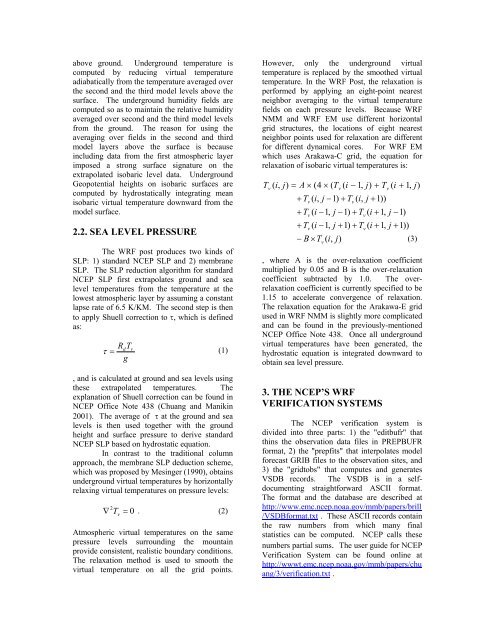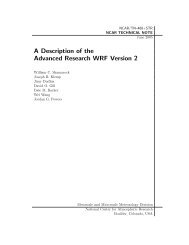NCEP'S WRF POST PROCESSOR AND VERIFICATION ... - MMM
NCEP'S WRF POST PROCESSOR AND VERIFICATION ... - MMM
NCEP'S WRF POST PROCESSOR AND VERIFICATION ... - MMM
Create successful ePaper yourself
Turn your PDF publications into a flip-book with our unique Google optimized e-Paper software.
above ground. Underground temperature is<br />
computed by reducing virtual temperature<br />
adiabatically from the temperature averaged over<br />
the second and the third model levels above the<br />
surface. The underground humidity fields are<br />
computed so as to maintain the relative humidity<br />
averaged over second and the third model levels<br />
from the ground. The reason for using the<br />
averaging over fields in the second and third<br />
model layers above the surface is because<br />
including data from the first atmospheric layer<br />
imposed a strong surface signature on the<br />
extrapolated isobaric level data. Underground<br />
Geopotential heights on isobaric surfaces are<br />
computed by hydrostatically integrating mean<br />
isobaric virtual temperature downward from the<br />
model surface.<br />
2.2. SEA LEVEL PRESSURE<br />
The <strong>WRF</strong> post produces two kinds of<br />
SLP: 1) standard NCEP SLP and 2) membrane<br />
SLP. The SLP reduction algorithm for standard<br />
NCEP SLP first extrapolates ground and sea<br />
level temperatures from the temperature at the<br />
lowest atmospheric layer by assuming a constant<br />
lapse rate of 6.5 K/KM. The second step is then<br />
to apply Shuell correction to τ, which is defined<br />
as:<br />
RdTv τ =<br />
(1)<br />
g<br />
, and is calculated at ground and sea levels using<br />
these extrapolated temperatures. The<br />
explanation of Shuell correction can be found in<br />
NCEP Office Note 438 (Chuang and Manikin<br />
2001). The average of τ at the ground and sea<br />
levels is then used together with the ground<br />
height and surface pressure to derive standard<br />
NCEP SLP based on hydrostatic equation.<br />
In contrast to the traditional column<br />
approach, the membrane SLP deduction scheme,<br />
which was proposed by Mesinger (1990), obtains<br />
underground virtual temperatures by horizontally<br />
relaxing virtual temperatures on pressure levels:<br />
2<br />
∇ T v = 0 . (2)<br />
Atmospheric virtual temperatures on the same<br />
pressure levels surrounding the mountain<br />
provide consistent, realistic boundary conditions.<br />
The relaxation method is used to smooth the<br />
virtual temperature on all the grid points.<br />
However, only the underground virtual<br />
temperature is replaced by the smoothed virtual<br />
temperature. In the <strong>WRF</strong> Post, the relaxation is<br />
performed by applying an eight-point nearest<br />
neighbor averaging to the virtual temperature<br />
fields on each pressure levels. Because <strong>WRF</strong><br />
NMM and <strong>WRF</strong> EM use different horizontal<br />
grid structures, the locations of eight nearest<br />
neighbor points used for relaxation are different<br />
for different dynamical cores. For <strong>WRF</strong> EM<br />
which uses Arakawa-C grid, the equation for<br />
relaxation of isobaric virtual temperatures is:<br />
Tv v<br />
+ T v ( i, j −1)<br />
+ Tv<br />
( i,<br />
j + 1))<br />
v<br />
Tv i −1,<br />
j −1)<br />
+ Tv<br />
( i + 1,<br />
Tv i −1,<br />
j + 1)<br />
+ Tv<br />
( i + 1,<br />
B × Tv<br />
( i,<br />
j)<br />
( i,<br />
j)<br />
= A × ( 4 × ( T ( i − 1,<br />
j)<br />
+ T ( i + 1,<br />
j)<br />
+ ( j −1)<br />
+ ( j + 1))<br />
− (3)<br />
, where A is the over-relaxation coefficient<br />
multiplied by 0.05 and B is the over-relaxation<br />
coefficient subtracted by 1.0. The overrelaxation<br />
coefficient is currently specified to be<br />
1.15 to accelerate convergence of relaxation.<br />
The relaxation equation for the Arakawa-E grid<br />
used in <strong>WRF</strong> NMM is slightly more complicated<br />
and can be found in the previously-mentioned<br />
NCEP Office Note 438. Once all underground<br />
virtual temperatures have been generated, the<br />
hydrostatic equation is integrated downward to<br />
obtain sea level pressure.<br />
3. THE NCEP’S <strong>WRF</strong><br />
<strong>VERIFICATION</strong> SYSTEMS<br />
The NCEP verification system is<br />
divided into three parts: 1) the "editbufr" that<br />
thins the observation data files in PREPBUFR<br />
format, 2) the "prepfits" that interpolates model<br />
forecast GRIB files to the observation sites, and<br />
3) the "gridtobs" that computes and generates<br />
VSDB records. The VSDB is in a selfdocumenting<br />
straightforward ASCII format.<br />
The format and the database are described at<br />
http://www.emc.ncep.noaa.gov/mmb/papers/brill<br />
/VSDBformat.txt . These ASCII records contain<br />
the raw numbers from which many final<br />
statistics can be computed. NCEP calls these<br />
numbers partial sums. The user guide for NCEP<br />
Verification System can be found online at<br />
http://wwwt.emc.ncep.noaa.gov/mmb/papers/chu<br />
ang/3/verification.txt .
















